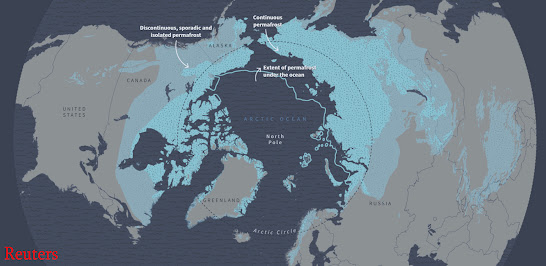Melting permafrost has become a new source for pathogens and added greenhouse gas emissions
At the current rate of global warming the
average temperature of the atmosphere for the planet has risen 1.5 degrees
Celsius over what it was at the beginning of the industrial age. During the
same time the temperature at the poles has risen as much as 4 times the amount
of the global average to as much as 6 degrees. Permafrost, which is land that
remains frozen for more than two years, is found in the most northern latitudes
and therefore has been dramatically affected by the 6 degree increase in
temperature. About a quarter of the northern hemisphere contains permafrost.
We are already seeing a host of things happening as a result of the thawing of
the world’s permafrost. The permafrost area where the world's depository of
seeds for future generations is being stored, the Norwegian
As we have discussed before in our article on feedback loops and tipping points, the effect of this thawing becomes a cycle that contributes to global warming. The major feedback loop for the thawing of the permafrost is the additional heating of the atmosphere occurring because of the release of carbon that was locked up in the permafrost in the form of plant and animal matter. As microbes decay this material, they produce carbon dioxide and methane. Unless the amount of carbon dioxide and methane is reduced in the atmosphere, this feedback loop will get stronger adding more heat to the atmosphere.
There are actions that we as individuals can
take to reduce global warming:
Reduce your use of greenhouse gas producing
fuels by reducing heating and cooling of homes and businesses. Take fewer trips
with the car.
Stop or reduce greatly the amount of animal food consumed. This greatly reduces the amount of methane sent into the atmosphere. It is also another double win. The land that was used for raising animals can now be turned from grassland into forested land and sequester large amounts of carbon dioxide.
Create as many reflective surfaces as you can. Reflective surfaces send back shortwave radiation that is not absorbed by greenhouse gases and therefore does not cause them to heat up. Black roofs and driveways heat up. White roofs and driveways reflect sunlight and remain relatively cool and only produce shortwave radiation.
References
1. Thawing permafrost puts global climate warming in spotlight (reuters.com)
2. As Climate Change Worsens, A Cascade of Tipping Points Looms - Yale E360
3. Nine climate tipping points now 'active,' warn scientists (phys.org)
4. What are Tipping Points in the Climate Crisis? | Earth.Org - Past | Present | Future
5. What are Climate Tipping Points? – climatetippingpoints.info
6. Climate tipping points — too risky to bet against (nature.com)
7. Explainer:
Nine ‘tipping points’ that could be triggered by climate change | Carbon Brief
8. Arctic stronghold of world’s seeds flooded after permafrost melts | Climate change | The Guardian
9. Anthrax Outbreak In Russia Thought To Be Result Of Thawing Permafrost : Goats and Soda : NPR
10. As
Permafrost Melts It's Unleashing Ancient Viruses, Carbon - And Now Fuel Spills
(sciencealert.com)




Comments
Post a Comment